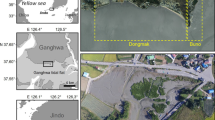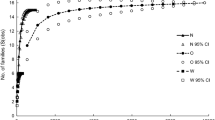Abstract
Patterns in the spatial arrangement of invasive plant populations can provide opportunity for strategic placement of control efforts. Smooth cordgrass (Spartina alterniflora) is rapidly invading the intertidal mudflats of Pacific Coast estuaries. Its pattern of spread is distinctive. Seedlings establish in open mud and then grow vegetatively to form expanding circular patches, which dot the mudflats and eventually coalesce into a contiguous monospecific meadow. The invasion typically begins in the upper tide zone and then moves down the tidal gradient. A spatially explicit model was used to simulate the spread of S. alterniflora and compare various strategies for control in a situation where only a fraction of the total infestation could be controlled each year. A strategy of killing outlying patches first and then attacking the dense meadows (moving up the tidal gradient) led to eradication with up to 44% less time and effort than a strategy of attacking the dense meadows first and outlying patches second (moving down the tidal gradient). In the control of contiguous meadows located adjacent to the shoreline, the best strategy was to approach one end of the infestation, moving across the meadow to the other end. Suppression of seeds was not an effective control strategy. In general, effective control strategies were those that first eliminate the plant in areas where current or future vegetative growth is greatest. Application of these results in control programs for S. alterniflora and similar invasive species could greatly reduce the costs of control work and improve the likelihood of local or complete eradication.
Similar content being viewed by others
References
E.. Audsley (1993) ArticleTitleOperational research analysis of patch spraying Crop Protection 12 111–119 Occurrence Handle10.1016/0261-2194(93)90137-8
HG.. Baker (1974) ArticleTitleThe evolution of weeds Annual Review of Ecology and Systematics 5 1–24 Occurrence Handle10.1146/annurev.es.05.110174.000245
D Blumenthal N. Jordan (2001) ArticleTitleWeeds in field margins: a spatially explicit simulation analysis of Canada thistle population dynamics Weed Science 49 509–519 Occurrence Handle1:CAS:528:DC%2BD3MXlsFOnsLo%3D
JB Buchanan (1997) ArticleTitleAbundance of shorebirds at Willapa Bay, Washington Western Birds 28 158–168
J Cardina GA Johnson DH. Sparrow (1997) ArticleTitleThe nature and consequences of weed spatial distribution Weed Science 45 364–373 Occurrence Handle1:CAS:528:DyaK2sXkt1WmsLY%3D
JS Clark M Silman R Kern E Macklin J. HilleRisLambers (1999) ArticleTitleSeed dispersal near and far: patterns across temperate and tropical forests Ecology 80 1475–1494
WRJ. Dean (1998) ArticleTitleSpace invaders: modeling the distribution, impacts and control of alien organisms Trends in Ecology and Evolution 13 256–258 Occurrence Handle10.1016/S0169-5347(98)01393-7
RF Denno GK Roderick MA Peterson AF Huberty HG Dobel MD Eubanks JE Losey GA.. Langellotto (1996) ArticleTitleHabitat persistence underlies intraspecific variation in the dispersal strategies of planthoppers Ecological Monographs 66 389–408
Ebasco Environmental. (1992). Element A: Spartina: Distribution, Biology, and Ecology. Final Report submitted to Washington State Department of Ecology
Ebasco Environmental. (1993). Element I: Integrated Weed Management Alternative for Managing Noxious Emergent Plants. Final Report submitted to Washington State Department of Ecology
WF Fagan JG. Bishop (2000) ArticleTitleTrophic interactions during primary succession: herbivores slow a plant reinvasion at Mount St Helens American Naturalist 155 328–251
Feist BE. (1999). Spatio-temporal analysis of the environmental and climatic factors controlling the expansion of Spartina alterniflora in Willapa Bay, Washington. PhD thesis. University of Washington
FS Grevstad DR Strong D Garcia-Rossi RW Switzer MS. Wecker (2003) ArticleTitleBiological control of Spartina alterniflora in Willapa Bay, Washington using the planthopper Prokelisia marginata: agent specificity and early results Biological Control 27 32–42 Occurrence Handle10.1016/S1049-9644(02)00181-0
FS Grevstad MS Wecker RW Switzer (2004) Habitat tradeoffs in the summer and winter performance of the planthopper Prokelisia marginata introduced against the intertidal grass Spartina alterniflora WA Willapa Bay J. Cullen (Eds) Proceedings of the XI International Symposium on Biological Control of Weeds, April, 2003 Canberra Australia, CSIRO
P Hedge LK Kriwoken K. Patten (2003) ArticleTitleA review of Spartina management in Washington State, US Journal of Aquatic Plant Management 41 82–90
SI Higgins DM. Richardson (1996) ArticleTitleA review of models of alien plant spread Ecological Modelling 87 249–265 Occurrence Handle10.1016/0304-3800(95)00022-4
SI Higgins DM Richardson RM. Cowling (2000) ArticleTitleUsing a dynamic landscape model for planning the management of alien plant invasions Ecological Applications 10 1833–1848
RJ Hobbs SE. Humphries (1995) ArticleTitleAn integrated approach to the ecology and management of plant invasions Conservation Biology 9 761–770 Occurrence Handle10.1046/j.1523-1739.1995.09040761.x
Isaacson DL, Sharratt DB, Coombs EM. (1996). Biological control in the management and spread of invasive weed species. In: Moran VC, Hoffmann JH. (eds). Proceedings of the IX International Symposium on Biological Control of Weeds, pp. 27–31. January 1996, Stellenbosch, South Africa, University of Cape Town
M Kot MA Lewis P. Driesshe Particlevan den (1996) ArticleTitleDispersal data and the spread of invading organisms Ecology 77 2027–2042
Mack RN, Lonsdale WM. (2002). Eradicating invasive plants: hard-won lessons for islands. In: Veitch CR. (ed). Turning the Tide: The Eradication of Invasive Species. Proceedings of the International Conference on Eradication of Island Invasives, February 2001, University of Auckland, Auckland, New Zealand, IUCN/SSC Invasive Species Specialist Group, Gland, Switzerland
ME Moody RN. Mack (1988) ArticleTitleControlling the spread of plant invasions: the importance of nacent foci Journal of Applied Ecology 25 1009–1021
KC. Murphy (2003) Report to the Legislature: Progress of the Spartina Eradication and Control Programs Washington State Department of Agriculture Olympia, WA
K. Patten (2002) ArticleTitleSmooth cordgrass. (Spartina alterniflora). control with Imazapyr Weed Technology 16 826–832 Occurrence Handle1:CAS:528:DC%2BD3sXptlyr
MER Paice W Day LJ Rew CL. Howard (1998) ArticleTitleA stochastic simulation model for evaluating the concept of patch spraying Weed Research 38 373–388 Occurrence Handle10.1046/j.1365-3180.1998.00108.x
B. Reeves (1999) Report to the Legislature: Progress of the Spartina and Purple Loosestrife Eradication and Control Programs Washington State Department of Agriculture Olympia, WA
M Ruckelshaus C Hartway P. Kareiva (1997) ArticleTitleAssessing the data requirements of spatially explicit dispersal models Conservation Biology 11 1298–1306 Occurrence Handle10.1046/j.1523-1739.1997.96151.x
EJ. Salisbury (1961) Weeds and Aliens Collins London
K. Sayce (1988) Introduced cordgrass, Spartina alterniflora Loisel, in salt marshes and tidelands of Willapa Bay, Washington Willapa National Wildlife Refuge Report Naselle, WA
CA Simenstad RM. Thom (1995) ArticleTitleSpartina alterniflora. (smooth cordgrass). as an invasive halophyte in Pacific Northwest estuaries Hortus Northwest 6 9–12
F Bosch Particlevan den JAJ Metz O. Diekmann (1990) ArticleTitleThe velocity of spatial population expansion Journal of Mathematical Biology 28 529–565 Occurrence Handle10.1007/BF00164162
JL Woolcock R. Cousens (2000) ArticleTitleA mathematical analysis of factors affecting the rate of spread of patches of annual weeds in an arable field Weed Science 48 27–34 Occurrence Handle1:CAS:528:DC%2BD3cXhvVekt7o%3D
Author information
Authors and Affiliations
Corresponding author
Rights and permissions
About this article
Cite this article
Grevstad, F.S. Simulating control strategies for a spatially structured weed invasion: Spartina alterniflora (Loisel) in Pacific Coast estuaries. Biol Invasions 7, 665–677 (2005). https://doi.org/10.1007/s10530-004-5855-1
Received:
Accepted:
Issue Date:
DOI: https://doi.org/10.1007/s10530-004-5855-1




